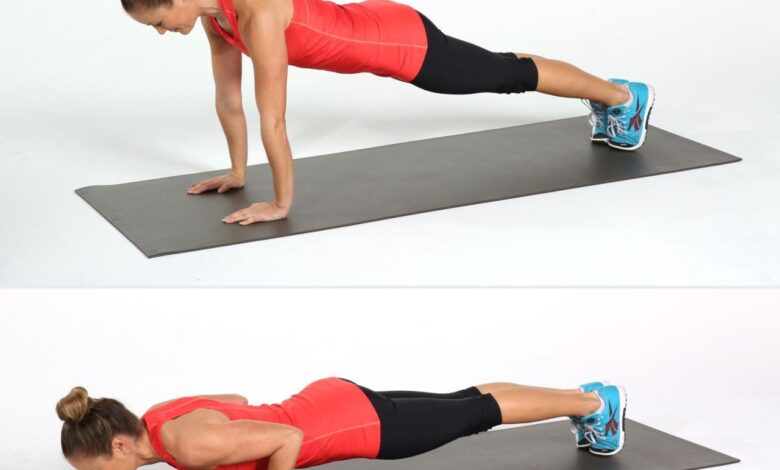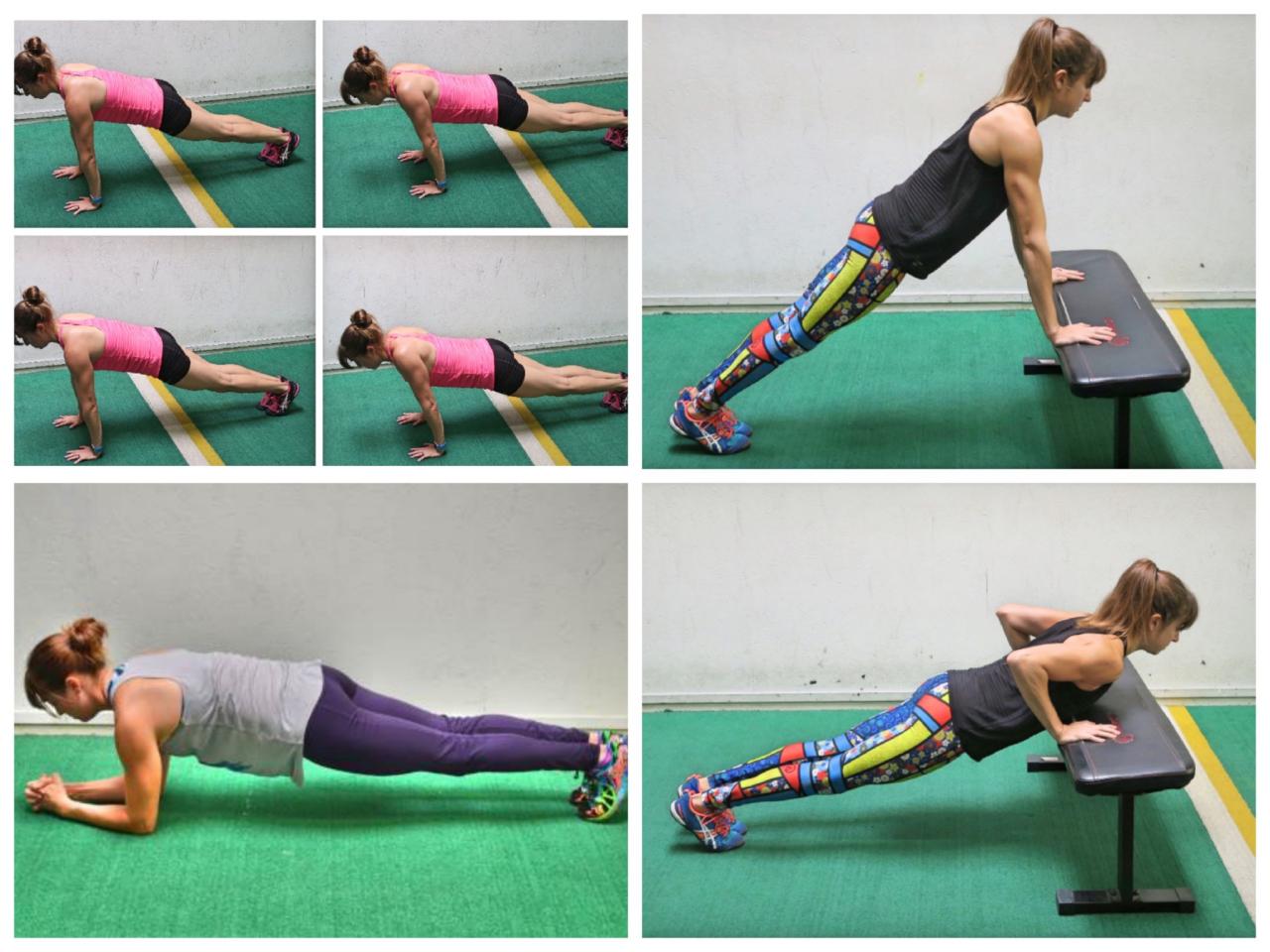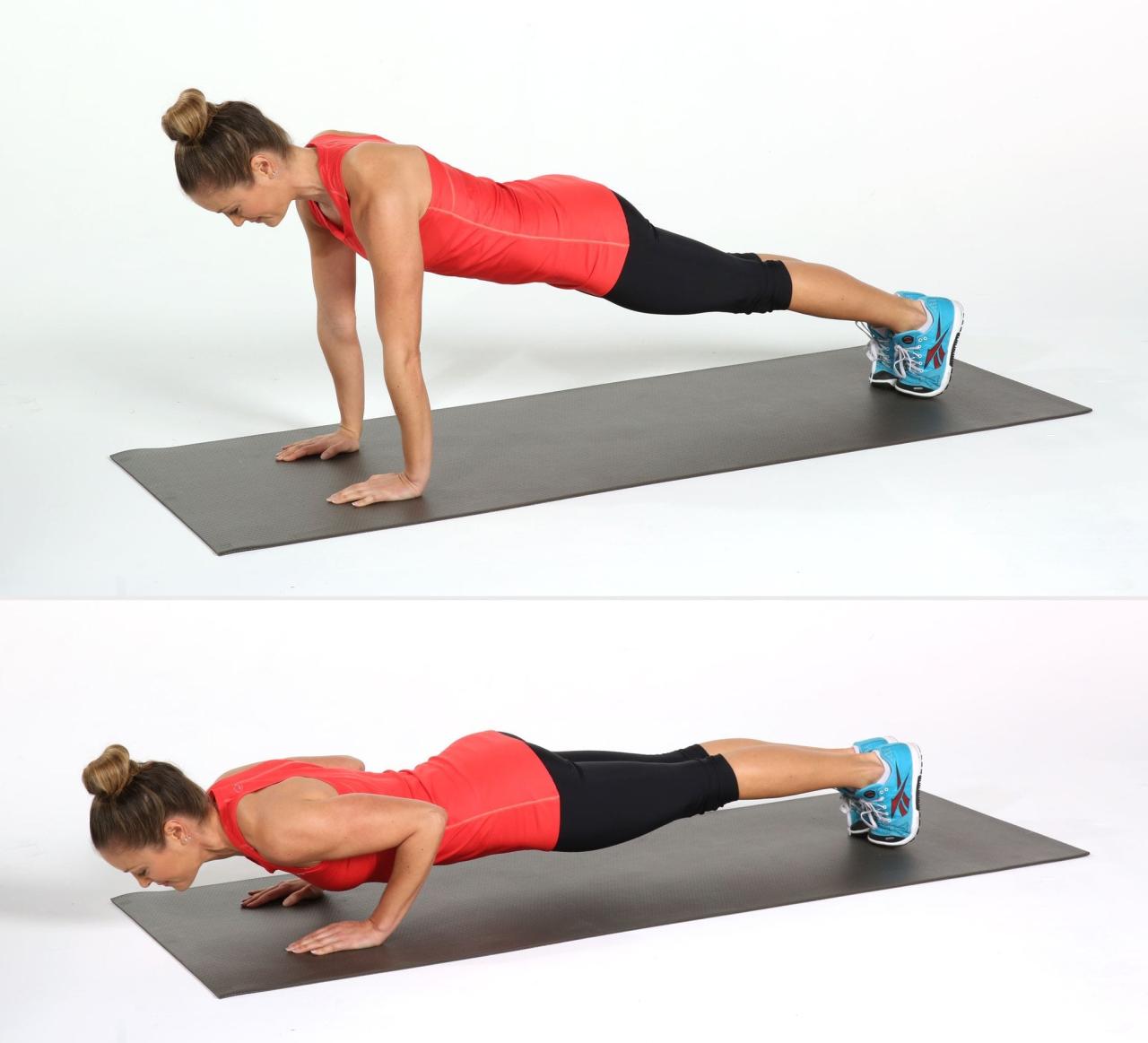
Push up how to is a comprehensive guide to mastering the fundamental exercise. This guide delves into proper form, technique, and variations, helping you progress safely and effectively. We’ll cover everything from the standard push-up to modifications for beginners and advanced variations.
We’ll explore the crucial elements of proper form, including hand placement, body alignment, and core engagement. You’ll learn how to execute standard push-ups with precision, understanding the nuances of different variations like incline and decline push-ups. Moreover, we’ll address common mistakes and provide personalized recommendations for safe and effective practice. We’ll also discuss the essential safety precautions to prevent injuries and provide a progression plan to gradually build strength and endurance.
Proper Form and Technique
Mastering the push-up is about more than just getting stronger; it’s about achieving proper form for optimal results and injury prevention. A strong foundation in technique will allow you to progress safely and effectively, building a solid base for more advanced exercises. Proper form prioritizes controlled movements, minimizing stress on joints and maximizing muscle engagement.
Hand Placement
Effective hand placement is crucial for maintaining body alignment and distributing weight evenly. Hands should be positioned slightly wider than shoulder-width apart, ensuring a stable base. This wider stance helps engage the chest muscles more effectively and provides a greater range of motion. Imagine the straight line formed from your shoulders to your wrists. Keeping this alignment consistent throughout the exercise is key to maintaining form.
Body Alignment
Maintaining a straight line from head to heels is essential for proper push-up form. This neutral spine position prevents strain on the lower back. Think of creating a rigid plank-like posture. Avoid sagging at the hips or arching the back. A consistent alignment maximizes the engagement of core muscles and stabilizes the body, reducing the risk of injury.
Core Engagement
Engaging the core is fundamental to a successful push-up. A strong core acts as a stabilizing force, supporting the body during the movement. Actively drawing your belly button towards your spine during the exercise is a crucial technique to enhance core engagement. This activation stabilizes the entire torso, enabling a more controlled and powerful movement.
Push-Up Variations
Different push-up variations target specific muscle groups and adjust the difficulty level. Understanding the differences in form and muscle engagement allows you to tailor your workouts.
- Standard Push-Up: This classic variation engages a wide range of muscles across the chest, shoulders, triceps, and core. The body maintains a straight line throughout the movement, emphasizing full range of motion.
- Incline Push-Up: By elevating your hands on a surface like a bench or a wall, you reduce the amount of body weight you’re pushing. This modification is gentler on the shoulders and chest, making it ideal for beginners.
- Decline Push-Up: Placing your feet on an elevated surface like a bench and positioning your hands on the ground creates a more challenging variation. This exercise places more emphasis on the triceps and shoulders, offering a more advanced workout.
Step-by-Step Guide to a Standard Push-Up
This detailed guide will Artikel the proper technique for performing a standard push-up, focusing on precision and safety.
- Starting Position: Begin in a plank position with your hands shoulder-width apart, directly beneath your shoulders. Maintain a straight line from head to heels. Engage your core to maintain stability.
- Lowering Phase: Inhale, slowly lower your chest towards the floor. Keep your core engaged and your body in a straight line. Avoid sagging at the hips or arching your back. Ensure that your elbows are slightly flared out, maintaining the natural angle of your shoulder joint.
- Pushing Phase: Exhale as you push back up to the starting position, maintaining the straight-line posture. Ensure your elbows are in line with your body, avoiding locking or hyperextending your elbows.
- Breathing Technique: Inhale as you lower yourself, and exhale as you push back up. This rhythmic breathing pattern promotes optimal oxygen intake and energy release during the exercise.
Common Mistakes and Corrections
Beginners often make these mistakes during push-ups, which can lead to injury or hinder progress.
- Sagging at the hips: Engage your core muscles to maintain a straight line from head to heels. This will stabilize your body and target the correct muscle groups.
- Arching the back: Keep your back straight and avoid arching it during the movement. This helps prevent injury and ensures proper core engagement.
- Dropping the head: Maintain a neutral neck position, aligned with your spine, throughout the exercise. This will prevent unnecessary stress on the neck.
- Locking the elbows: Keep your elbows slightly flared out and avoid locking them completely during the push-up. This helps prevent strain on the elbow joints.
Breathing Technique
Proper breathing is essential for optimal performance and reducing fatigue during push-ups.
- Inhale on the Descent: Inhale deeply as you lower your body towards the ground. This helps maintain a steady pace and allows for adequate oxygen intake.
- Exhale on the Ascent: Exhale forcefully as you push your body back up to the starting position. This helps to generate power and promote a controlled movement.
Muscle Engagement Table
The table below Artikels the key muscle groups worked during push-ups, along with their specific functions.
| Muscle Group | Function | Example Movement |
|---|---|---|
| Pectorals | Chest movement | Pushing the body up |
| Triceps | Extension of the elbow | Straightening the arms |
| Deltoids | Shoulder stabilization | Maintaining shoulder position |
| Core Muscles | Body stabilization | Maintaining plank posture |
| Anterior Shoulder | Stabilizing the shoulder joint | Maintaining proper shoulder posture |
Progression and Modifications
Mastering the push-up is a journey, not a sprint. Building strength and endurance takes time and dedication. This section details a structured progression plan, focusing on modifications for various fitness levels and abilities. Understanding these modifications and progressions is key to preventing injury and ensuring a safe and effective workout.This section provides a roadmap to help you safely and effectively increase your push-up strength and capability.
It’s crucial to progress gradually, focusing on proper form over quantity, to avoid setbacks and maximize results. The modifications Artikeld will help you adapt push-ups to suit your current abilities, making it accessible for everyone.
Progression Plan for Building Push-Up Strength
A well-structured progression plan ensures a gradual increase in difficulty, allowing your body to adapt and preventing plateaus or injuries. Begin with easier variations and progressively increase the challenge as strength improves.
Mastering the perfect push-up form is key for building upper body strength. Proper hand placement and a controlled descent are crucial. But did you know that factors like nutrition can also play a role in recovery time? For example, exploring whether wounds heal faster in a caloric surplus is an interesting area of research. do wounds heal faster in a caloric surplus.
Ultimately, focusing on the right technique will give you the best results in your push-up journey.
- Beginner (Knee Push-Ups): Start with knee push-ups on a slightly elevated surface like a bench or a few stacked books. This reduces the load on your shoulders and chest, making it easier to maintain good form. Focus on maintaining a straight line from head to heels and controlled movements.
- Intermediate (Incline Push-Ups): As strength increases, move to incline push-ups on a lower incline, such as a chair or a countertop. This variation further reduces the load on the chest and shoulders while still engaging the pushing muscles. Maintain proper form, with a straight line from head to heels.
- Intermediate (Modified Push-Ups on the floor): Once you can comfortably perform 10-15 repetitions of incline push-ups with good form, progress to standard push-ups on the floor. Use your hands as your support point, ensuring your body forms a straight line from head to heels. Focus on controlled movements and maintain proper form.
- Advanced (Standard Push-Ups): After mastering standard push-ups, you can increase the challenge by decreasing the support surface, gradually lowering your hands to increase the difficulty.
- Advanced (Decline Push-Ups): For further progression, try decline push-ups, where your feet are elevated. This increases the load on the pushing muscles, particularly the chest. Maintain a straight line from head to heels, with controlled movements. Ensure your body forms a straight line from head to heels throughout the entire movement.
Modifications for Limited Mobility or Strength
Individuals with limited mobility or strength can adapt push-ups to accommodate their needs. These modifications are vital for safe and effective workouts.
- Incline Push-Ups: Using an elevated surface like a table or bench, you reduce the required range of motion and force needed to perform the exercise. This is particularly beneficial for individuals with shoulder or wrist issues, or those starting their push-up journey. A higher incline surface will further reduce the intensity.
- Knee Push-Ups: Performing push-ups with your knees on the ground instead of your feet decreases the overall load on your body, allowing for a greater range of motion with reduced stress on the chest and shoulders. This modification is suitable for beginners or individuals with limited upper body strength.
- Assisted Push-Ups: Use resistance bands or a partner to assist with the movement, reducing the amount of force needed to perform the exercise. This allows individuals to practice proper form without excessive stress.
Different Push-Up Variations
Expanding your push-up repertoire can add variety and challenge to your workouts.
- Standard Push-Ups: The fundamental push-up variation, engaging chest, shoulders, and triceps. Hands are shoulder-width apart, body in a straight line from head to heels.
- Wide-Grip Push-Ups: Hands are wider than shoulder-width apart, targeting the outer chest muscles. This variation can be challenging, focusing on shoulder stability and balance.
- Close-Grip Push-Ups: Hands are closer than shoulder-width apart, emphasizing the triceps and inner chest. Maintaining proper form is essential to avoid injury.
- Diamond Push-Ups: Hands are close together, forming a diamond shape under the chest. This variation is particularly challenging for the triceps.
- Decline Push-Ups: Feet are elevated, increasing the difficulty by challenging the pushing muscles more intensely. Ensure a straight line from head to heels.
Modifying Push-Ups for Different Fitness Levels and Abilities
Adjusting push-up variations and modifications based on individual fitness levels and abilities is crucial for safety and effectiveness.
- Beginners: Start with knee push-ups or incline push-ups to build strength and control before progressing to standard push-ups.
- Intermediate: Gradually increase the number of repetitions and sets of standard push-ups and incorporate variations like wide-grip and close-grip push-ups.
- Advanced: Explore more challenging variations like decline push-ups, clap push-ups, and push-ups on unstable surfaces. Increase the number of sets and repetitions.
Importance of Gradual Increase in Repetitions and Sets
Gradually increasing the number of repetitions and sets is crucial for preventing injury and maximizing results. Rushing the process can lead to overuse injuries. Listen to your body and adjust the plan as needed.
Safety and Precautions

Push-ups, a fantastic bodyweight exercise, offer numerous benefits. However, like any physical activity, they come with inherent risks if proper precautions aren’t taken. Understanding these risks and implementing safety measures is crucial for injury prevention and a positive workout experience. This section delves into the vital aspects of safety, focusing on warm-up and cool-down routines, potential injuries, and recovery strategies.
Importance of Warm-up and Cool-down
A proper warm-up is essential before any exercise, including push-ups. It prepares the muscles for the exertion by increasing blood flow and raising body temperature. A dynamic warm-up, involving movements like arm circles and shoulder rotations, is particularly beneficial. A cool-down, performed after the exercise, helps the body return to its resting state, preventing muscle soreness and promoting recovery.
This includes static stretches, holding each stretch for 15-30 seconds.
Potential Injuries and Preventative Measures
Several injuries can arise from improper push-up technique or excessive training. Common injuries include shoulder impingement, wrist strains, and elbow pain. Maintaining proper form, using appropriate modifications, and gradually increasing the intensity of workouts are key preventative measures. Listen to your body and avoid pushing through pain.
Signs and Symptoms of Common Push-up Injuries
Recognizing the signs and symptoms of potential injuries is crucial for prompt intervention. Shoulder impingement may manifest as pain in the shoulder joint, especially during overhead movements. Wrist strains can cause pain and swelling in the wrist, often accompanied by tenderness. Elbow pain might indicate issues with the elbow joint, possibly from overuse or improper form. Rest and ice are initial remedies; however, consulting a medical professional is recommended for serious injuries.
Rest and Recovery Strategies
Overtraining can lead to various issues, including burnout and injury. Allowing adequate rest between workouts allows the muscles to recover and rebuild. Rest days are essential for optimal muscle repair. Proper nutrition, sufficient sleep, and hydration also play a critical role in recovery.
Listening to Your Body
Pain is your body’s way of communicating that something is wrong. It’s crucial to listen to your body and stop the exercise if you experience pain. Continuing through pain can exacerbate the injury. Prioritize your well-being and modify the exercise if needed.
Key Safety Considerations
| Safety Consideration | Explanation | Recommendation |
|---|---|---|
| Proper Form | Maintaining correct posture prevents injuries | Follow the guidelines provided in the form and technique section. |
| Warm-up | Prepare the muscles for exercise | Perform 5-10 minutes of light cardio and dynamic stretches, focusing on shoulder, wrist, and elbow mobility. |
| Cool-down | Return the body to its resting state | Perform static stretches, holding each stretch for 15-30 seconds, targeting the same muscle groups as the warm-up. |
| Progressive Overload | Gradually increase intensity to avoid overexertion | Increase the number of reps, sets, or the difficulty of the push-up variation gradually over time. |
| Listen to Your Body | Recognize pain as a signal to stop | Do not push through pain. Modify the exercise or stop if discomfort arises. |
Push-up Variations and Benefits

The humble push-up, a cornerstone of strength training, offers a multitude of variations, each targeting specific muscle groups and skill levels. This exploration delves into the diverse world of push-up modifications, highlighting their unique benefits and suitability for various fitness goals. Understanding these variations empowers you to tailor your workouts to your individual needs and progress effectively.
Exploring Push-up Variations
Different push-up variations cater to varying strength levels and fitness goals. By modifying the standard push-up, you can adjust the intensity and target different muscle groups. This section details the variations and their associated benefits.
Incline Push-ups
Incline push-ups are a fantastic starting point for beginners or individuals seeking a less demanding alternative to standard push-ups. By elevating your hands on a bench, chair, or elevated surface, you reduce the amount of weight your chest and arms need to bear. This modification makes the exercise easier to execute, allowing you to build strength gradually and focus on proper form before progressing to more challenging variations.
This gradual progression is key to preventing injuries and fostering long-term fitness gains.
Decline Push-ups
Decline push-ups are the opposite of incline push-ups. With your feet elevated on a surface, you increase the challenge. This variation emphasizes the triceps and shoulder muscles, leading to a more advanced workout for intermediate and advanced users. The increased demand on these muscles translates to greater strength and endurance gains.
Clap Push-ups
Clap push-ups are an exhilarating variation that adds an explosive element to the exercise. After performing a standard push-up, you add a clap between your hands just before you push back up. This requires significant strength and coordination. Clap push-ups demand a higher level of upper body power and core engagement. This variation enhances strength and speed simultaneously.
Standard Push-ups, Push up how to
Standard push-ups are a full-body exercise that works multiple muscle groups simultaneously. They are an excellent way to build overall upper body strength, particularly in the chest, shoulders, and triceps. They also engage the core muscles, contributing to core stability and overall fitness. They are considered the gold standard for building comprehensive upper body strength and are suitable for intermediate and advanced users.
Benefits of Push-ups for Upper Body Strength, Core Stability, and Overall Fitness
Push-ups are an exceptionally effective exercise for developing upper body strength. They target a multitude of muscles, from the chest and shoulders to the triceps and core. This comprehensive engagement builds overall upper body strength and endurance. Beyond upper body strength, push-ups play a crucial role in core stability. The effort required to maintain proper form during push-ups engages the core muscles, promoting stability and preventing injury.
This core engagement extends to overall fitness, contributing to improved posture, balance, and functional strength. The combination of strength, stability, and fitness makes push-ups an invaluable exercise.
Mastering the perfect push-up form is key for building strength, but sometimes you need a little extra motivation. That’s where apps like big shots get shots iphone app come in handy, providing engaging challenges and visual cues to help you track your progress. After all, consistent practice and proper form are crucial for achieving your push-up goals, so keep pushing!
Advantages of Incorporating Push-ups into a Workout Routine
Incorporating push-ups into a workout routine offers a multitude of advantages. They are a time-efficient exercise, requiring minimal equipment and allowing for quick and effective strength training. Push-ups are adaptable, accommodating various fitness levels through modifications. Furthermore, push-ups can be performed almost anywhere, making them a convenient exercise option. The flexibility of push-ups makes them a valuable addition to any fitness routine.
Comparison of Push-up Variations
The different push-up variations offer distinct benefits and challenges. Incline push-ups are ideal for beginners, while decline push-ups challenge intermediate and advanced users. Clap push-ups demand significant upper body power and coordination. Standard push-ups provide a balanced full-body workout. The choice of variation depends on your individual fitness level and goals.
Mastering the perfect push-up form is key to building strength and core stability. Beyond the physical benefits, a healthy diet rich in fiber plays a vital role in overall well-being and disease prevention. Learning how much fiber should we eat to prevent disease is crucial, and a balanced approach to nutrition is just as important as the correct push-up technique.
So, next time you’re working on your push-up how to, remember to prioritize a balanced diet. how much fiber should we eat to prevent disease. Focus on proper hand placement and controlled movements to ensure effective workouts.
Each variation offers a unique pathway to building strength and fitness.
Summary Table of Push-up Variations and Their Benefits
| Variation | Benefits | Suitable For |
|---|---|---|
| Standard Push-ups | Full body workout, excellent for building overall upper body strength and core stability. | Intermediate and advanced |
| Incline Push-ups | Easier variation, perfect for beginners and those with limited strength. Focuses on building strength progressively. | Beginners and those with limited strength |
| Decline Push-ups | More challenging, emphasizes triceps and shoulder strength, ideal for intermediate and advanced users. | Intermediate and advanced |
| Clap Push-ups | Explosive exercise, improves upper body power and coordination. | Intermediate and advanced |
Equipment and Environment
Push-ups are a fantastic bodyweight exercise, but incorporating the right equipment and environment can elevate your workout experience and maximize results. This section dives into the essential factors beyond just your body and the floor. From supportive surfaces to specialized tools, we’ll explore how to optimize your push-up practice for safety and effectiveness.Properly designed equipment and a supportive environment are crucial for a safe and productive push-up routine.
This includes understanding what surfaces are suitable, identifying helpful equipment, and creating a comfortable exercise space.
Equipment Enhancements
Using supplementary equipment can enhance your push-up experience, catering to different fitness levels and goals. This includes modifying the difficulty or adding resistance to target specific muscle groups more effectively.
| Equipment | Description | Use Cases |
|---|---|---|
| Incline Bench | An elevated surface, typically a bench or similar, used to modify push-ups. | Perfect for beginners to gradually increase the challenge as strength develops. Reduces the initial strain on the shoulders and chest. |
| Resistance Bands | Elastic bands placed around the hands or feet to add resistance. | Effective for improving strength and endurance by increasing the force required during the push-up. Useful for advanced users looking for a greater challenge. |
| Stability Ball | A large inflatable ball used for core engagement. | Push-ups performed on a stability ball challenge the core muscles more significantly. |
| Weighted Vest | A vest loaded with weights, worn during exercises to add resistance. | A practical way to add significant resistance for advanced users who want to progressively overload the muscles. |
Safe and Supportive Environment
A well-chosen environment significantly impacts the effectiveness and safety of your push-up routine. The surface you work on, the surrounding area, and even the lighting can all play a part.
- Surface Selection: A firm, stable surface is paramount. Avoid uneven surfaces, soft mats, or anything that might cause you to lose your balance. A wooden floor, a sturdy yoga mat, or even a smooth concrete floor are good options. A carpeted floor can be too soft and potentially dangerous for push-ups.
- Space Considerations: Ensure adequate space around you to prevent collisions or tripping hazards. Clear the area of any obstacles that might interfere with your form or movement. A spacious workout room or a dedicated area in your home are ideal.
- Lighting and Ventilation: Adequate lighting is essential for proper form assessment. Good ventilation will help prevent overheating during your workout.
Last Point: Push Up How To
In conclusion, mastering the push-up involves understanding proper form, technique, and variations. By following the guidelines provided in this comprehensive guide, you can safely and effectively incorporate push-ups into your workout routine. Remember to prioritize proper warm-up, cool-down, and rest to optimize your results and minimize the risk of injuries. We hope this guide empowers you to confidently tackle push-ups and experience the numerous benefits they offer.




